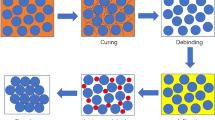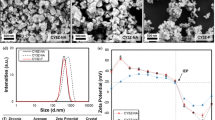Abstract
Zirconia-based ceramic has generated considerable interest in specialist structural/engineering ceramics. Among current available additive manufacturing methods for fabrication of ceramic components, the conventional material jetting systems are able to create local deposition of thin layers, dense green bodies, and complex shapes. However, this method is mainly limited to low viscous ceramic inks (mostly in the range of 20–40 mPa/s) with often less than 25 vol% solid loading which has restricted the widespread adoption of this technique. In this work, we employed a novel in-house developed hybrid drop-on-demand material jetting system (DODMJ) to deposit a highly viscous paste (up to 72 wt% solid content, a viscosity of 2100 mPa/s) of yttria-stabilized-zirconia (YSZ), with approximately 20 times higher speed than the current material jetting methods, for the first time. For this study, tetragonal zirconia polycrystal containing 8 wt% Y2O3 (5Y-TPZ), which is commonly used to produce dental restorations by subtractive manufacturing, was utilized. The printability of several visible light–curable zirconia pastes was studied in terms of the rheology, paste composition, solid content, and printing parameters. The density and porosity measurements as well as a two-stage sintering process to achieve fully dense and crack-free parts were carried out. The microstructure and internal features of the printed parts were also explored by X-ray nano-computed tomography (CT) scanning and scanning electron microscopy (SEM). In this work, standard test methods were also utilized to study the Vickers hardness and fracture toughness of the sintered 5Y-TPZ parts for the first time. The results showed that specimens produced with the paste containing 62.3 wt% solid loading yielded a relative density of 99.5% and presented an average fracture toughness and micro-hardness of 5.62 MPa/m0.5 and 1516 HV, respectively. Overall, the outcomes presented in this work confirmed that the novel DODMJ technique adopted for this study has great potential in the development of a feasible, high-speed, and cost-effective manufacturing system to produce zirconia ceramic parts with adequate mechanical and structural properties that meet the demanding requirements for various applications such as dental crowns restoration.









Similar content being viewed by others
References
Chevalier J (2006) What future for zirconia as a biomaterial? Biomaterials 27:535–543. https://doi.org/10.1016/j.biomaterials.2005.07.034
Richerson DW (2006) Modern ceramic engineering, 3rd edn. Taylor and Francis Group LLC, Boca Raton
Shackelford JF, Doremus RH (2008) Ceramic and glass materials: structurs, properties, and procesing. Newyork, USA
Llanos G (2018) Additive Manufacturing of Zirconia (Master Dissertation), Chalmers University of Technology, Sweden https://hdl.handle.net/20.500.12380/255513
Zhou ZR, Zheng J (2008) Tribology of dental materials: a review. J Phys D Appl Phys 4:113001. https://doi.org/10.1088/0022-3727/41/11/113001
Kim KT, Park SWCH (1998) Densification behavior of ceramic powder under cold compaction. J Eng Mater Technol 122:238–244. https://doi.org/10.1115/1.482793
Langer J, Hoffmann MJ, Guillon O (2011) Electric field-assisted sintering and hot pressing of semiconductive zinc oxide: a comparative study. J Am Ceram Soc 94:2344–2353. https://doi.org/10.1111/j.1551-2916.2011.04396.x
Christel P, Meunier A, Heller M, Torre JP, Peille CN (1989) Mechanical properties and short-term in vivo evaluation of yttrium-oxide-partially-stabilized zirconia. J Biomed Mater Res 23:45–61. https://doi.org/10.1002/jbm.820230105
Maca K, Trunec M, Dobsak P (2005) Bulk zirconia nanoceramics prepared by cold isostatic pressing and pressureless sintering. Rev Adv Mater Sci 10:84–88
Huisman W, Graule T, Gauckler LJ (1994) Centrifugal slip casting of zirconia (TZP). J Eur Ceram Soc 13:33–39. https://doi.org/10.1016/0955-2219(94)90055-8
Snijkers F, Ade W, Mullens S, Luyten J (2004) Aqueous tape casting of yttria stabilised zirconia using natural product binder. J Eur Ceram Soc 24:1107–1110. https://doi.org/10.1016/S0955-2219(03)00388-1
Lin SIE (2001) Near-net-shape forming of zirconia optical sleeves by ceramics injection molding. Ceram Int 27:205–214. https://doi.org/10.1016/S0272-8842(00)00065-1
Wu H, Liu W, He R, Wu Z, Jiang Q, Song X, Chen Y, Cheng L, Wu S (2017) Fabrication of dense zirconia-toughened alumina ceramics through a stereolithography-based additive manufacturing. Ceram Int 43:968–972. https://doi.org/10.1016/j.ceramint.2016.10.027
Zocca A, Colombo P, Gomes CM, Günster J (2015) Additive manufacturing of ceramics: issues, potentialities, and opportunities. J Am Ceram Soc 98:1983–2001. https://doi.org/10.1111/jace.13700
Travitzky BN, Bonet A, Dermeik B, Fey T, Filbert-demut I, Schlier L, Schlordt T, Greil P (2014) Additive manufacturing of ceramic-based materials. Adv Eng Mater 16:729–754. https://doi.org/10.1002/adem.201400097
Ebert J, Özkol E, Zeichner A, Telle R, Fischer H (2009) Direct inkjet printing of dental prostheses made of zirconia. J Dent Res 88(7):673–676. https://doi.org/10.1177/0022034509339988
Tay BY, Evans JRG, Edirisinghe MJ, Tay BY (2003) Solid freeform fabrication of ceramics. Int Mater Rev 48:341–370. https://doi.org/10.1179/095066003225010263
Doreau F, Chaput C, Chartier T (2000) Stereolithography for manufacturing ceramic parts. Adv Eng Mater 2:493–496. https://doi.org/10.1002/1527-2648(200008)2:8<493::AID-ADEM493>3.0.CO;2-C
Lv X, Ye F, Cheng L, Fan S, Liu Y (2019) Binder jetting of ceramics : powders , binders , printing parameters , equipment, and post-treatment. Ceram Int 45:12609–12624. https://doi.org/10.1016/j.ceramint.2019.04.012
Shanjani Y, Hu Y, Pilliar RM, Toyserkani E (2011) Mechanical characteristics of solid-freeform-fabricated porous calcium polyphosphate structures with oriented stacked layers. Acta Biomater 7:1788–1796. https://doi.org/10.1016/j.actbio.2010.12.017
Shanjani Y, Hu Y, Toyserkani E, Grynpas M, Kandel RA, Pilliar RM (2013) Solid freeform fabrication of porous calcium polyphosphate structures for bone substitute applications: in vivo studies. J Biomed Mater Res - Part B Appl Biomater 101(B):972–980. https://doi.org/10.1002/jbm.b.32905
Chen A, Wu J, Liu K, Chen J, Xiao H, Chen P (2018) High-performance ceramic parts with complex shape prepared by selective laser sintering : a review. Adv Appl Ceram 117(4):1–18. https://doi.org/10.1080/17436753.2017.1379586
Hollander DA, Wirtz T, Von Walter M, Linker R, Schultheis A, Paar O (2003) Development of individual three-dimensional bone substitutes using “selective laser melting”. Eur J Trauma 29:228–234. https://doi.org/10.1007/s00068-003-1332-2
Zhao X, Evans JRG, Edirisinghe MJ, Song JH (2002) Direct ink-jet printing of vertical walls. J Am Ceram Soc 85:2113–2115. https://doi.org/10.1111/j.1151-2916.2002.tb00414.x
Chen Z, Li Z, Li J, Liu C, Lao C, Fu Y, Liu C, Li Y, Wang P, He Y (2019) 3D printing of ceramics : a review. J Eur Ceram Soc 39:661–687. https://doi.org/10.1016/j.jeurceramsoc.2018.11.013
Griffith ML, Halloran JW (1996) Freeform fabrication of ceramics via streolithography. J Am Ceram Soc 79(10):2601–2608. https://doi.org/10.1111/j.1151-2916.1996.tb09022.x
Rosa M, Barou C, Esposito V (2018) Zirconia UV-curable colloids for additive manufacturing via hybrid inkjet. Mater Lett 215:214–217. https://doi.org/10.1016/j.matlet.2017.12.096
Ebert J, Özkol E, Telle R, Fischer H, Uibel K (2008) Direct inkjet printing: a versatile method of complex shape manufacturing. The 10th International Conference of the European Ceramic Society
Özkol E, Ebert J, Uibel K, Wätjen AM, Telle R (2009) Development of high solid content aqueous 3Y-TZP suspensions for direct inkjet printing using a thermal inkjet printer. J Eur Ceram Soc 29:403–409. https://doi.org/10.1016/j.jeurceramsoc.2008.06.020
Wang JC, Dommati H, Hsieh SJ (2019) Review of additive manufacturing methods for high-performance ceramic materials. Int J Adv Manuf Technol 103:2627–2647. https://doi.org/10.1007/s00170-019-03669-3
Derby B (2019) Inkjet printing ceramics : from drops to solid. J Eur Ceram Soc 31(14):2543–2550. https://doi.org/10.1016/j.jeurceramsoc.2011.01.016
Derby B (2010) Inkjet printing of functional and structural materials : fluid property requirements , feature stability, and resolution. Annu Rev Mater Res 40:395–414. https://doi.org/10.1146/annurev-matsci-070909-104502
Aminayi P, Young BR, Young TL, Sprowl LH, Joyce MK (2017) Inkjet printing and surface treatment of an optimized polyurethane-based ink formulation as a suitable insulator over silver for contact with aqueous-based fluids in low-voltage applications. J Coatings Technol Res 14:641–649. https://doi.org/10.1007/s11998-016-9882-5
Derby B, Reis N (2003) Inkjet printing of highly loaded particulate suspensions. MRS Bull 28:815–818. https://doi.org/10.1557/mrs2003.230
De Gans BJ, Duineveld PC, Schubert US (2004) Inkjet printing of polymers: state of the art and future developments. Adv Mater 16:203–213. https://doi.org/10.1002/adma.200300385
Ghazanfari A, Li W, Leu MC, Hilmas GE (2016) A novel extrusion-based additive manufacturing process for ceramic parts. Solid Freeform Fabr Symp 2016:1509–1529
Zhan Z, An J, Wei Y, Tran VT, Du H (2017) Inkjet-printed optoelectronics. Nanoscale 9:965–993. https://doi.org/10.1039/c6nr08220c
Robin M, Kuai W, Amela-Cortes M, Cordier S, Molard Y, Mohammed-Brahim T, Jacques E, Harnois M (2015) Epoxy based ink as versatile material for inkjet-printed devices. ACS Appl Mater Interf 7:21975–21984. https://doi.org/10.1021/acsami.5b06678
Lewis JA, Smay JE, Stuecker J, Cesarano J (2006) Direct ink writing of three-dimensional ceramic structures. J Am Ceram Soc 89:3599–3609. https://doi.org/10.1111/j.1551-2916.2006.01382.x
Bienia M, Lejeune M, Chambon M, Baco-Carles V, Dossou-Yovo C, Noguera R, Rossignol F (2016) Inkjet printing of ceramic colloidal suspensions: filament growth and breakup. Chem Eng Sci 149:1–13. https://doi.org/10.1016/j.ces.2016.04.015
Manogharan G, Kioko M (2015) Binder jetting: a novel solid oxide fuel-cell fabrication process and evaluation. Miner Metals Mater Soc 67:660–667. https://doi.org/10.1007/s11837-015-1296-9
Liravi F, Toyserkani E (2018) A hybrid additive manufacturing method for the fabrication of silicone bio-structures: 3D printing optimization and surface characterization. Mater Des 138:46–61. https://doi.org/10.1016/j.matdes.2017.10.051
Sideridou ID, Karabela MM (2009) Effect of the amount of 3- methacyloxypropyltrimethoxysilane coupling agent on physical properties of dental resin nanocomposites. Dent Mater 25(11):1315–1324. https://doi.org/10.1016/j.dental.2009.03.016
Yang H, He Y, Tuck C, Wildman R, Ashcroft I, Dickens P, Hague R (2013) High viscosity jetting system for 3D reactive inkjet printing. 24th Annual international solid freeform fabrication symposium; an additive manufacturing conference, proceedings; Austin, TX, pp 505–513
Yu PC, Li QF, Fuh JYH, Li T, Lu L (2007) Two-stage sintering of nano-sized yttria stabilized zirconia process by powder injection moulding. J Mater Process Technol 193:312–318. https://doi.org/10.1016/j.jmatprotec.2007.04.097
Wang JC, Dommati h (2018) Fabrication of zirconia ceramic parts by using solvent-based slurry stereolithography and sintering. Int J Adv Manuf Technol 98:1537–1546. https://doi.org/10.1007/s00170-018-2349-3
Slamovich EB, Lange FE (1992) Densification of large pores. J Am Ceram Soc 75(9):2498–2508. https://doi.org/10.1111/j.1151-2916.1992.tb05603.x
Kellett BJ, Angeles L (1989) Thermodynamics of densification: I, sintering of simple particle arrays, equilibrium configurations, pore stability, and shrinkage. J Am Ceram Soc 72(5):725–734. https://doi.org/10.1111/j.1151-2916.1989.tb06208.x
Kingery OD, Francois B (1967) Sintering of crystalline oxides, 1: interaction between grain boundaries and pores. Gordon and Breach, New York
Tekeli S (2006) The flexural strength, fracture toughness, hardness and densification behaviour of various amount of Al2O3-doped 8YSCZ/Al2O3 composites used as an electrolyte for solid oxide fuel cell. Mater Des 27:230–235. https://doi.org/10.1016/j.matdes.2004.10.011
Lee S, Jiang C (2015) Development of a three-dimensional slurry printing system using dynamic mask projection for fabricating zirconia dental implants. Mater Manuf Process 30:1498–1504. https://doi.org/10.1080/10426914.2014.984208
Paredes M, Serro AP (2017) Optimization of zirconia-based pastes for additive manufacturing of dental prosthesis. Master Dissertation, University of Tecnico Lisboa, Portugal
Liang KM, Orange G, Fantozzi G (1990) Evaluation by indentation of fracture toughness of ceramic materials. J Mater Sci 25:207–214. https://doi.org/10.1007/BF00544209
Ghazanfari A, Li W, Leu MC, Watts JL, Hilmas GE (2017) Additive manufacturing and mechanical characterization of high density fully stabilized zirconia. Ceram Int 43:6082–6088. https://doi.org/10.1016/j.ceramint.2017.01.154
Marinis A, Aquilino SA, Lund PS, Gratton DG, Stanford CM, Diaz-Arnold AM, Qian F (2013) Fracture toughness of yttria-stabilized zirconia sintered in conventional and microwave ovens. J Prosthet Dent 109:165–171. https://doi.org/10.1016/S0022-3913(13)60037-2
Mercer C, Williams JR, Clarke DR, Evans AG (2007) On a ferroelastic mechanism governing the toughness of metastable tetragonal-prime (t′) yttria-stabilized zirconia. Proc R Soc A Math Phys Eng Sci 463:1393–1408. https://doi.org/10.1098/rspa.2007.1829
Davoodi E, Fayazfar H, Liravi F, Jabari E, Toyserkani E (2020) Drop-on-demand high-speed 3D printing of flexible milled carbon fiber/silicone composite sensors for wearable biomonitoring devices. Addit Manuf 32:101016. https://doi.org/10.1016/j.addma.2019.101016
Acknowledgments
The authors would like to thank Dr. Ehsan Marzbanrad and Reza Esmaeilizadeh for helping with SEM imaging, sintering, and hardness experiments.
Statement of contribution
Haniyeh Fayazfar: Conceptualization, Experimentation (zircona paste preparation, 3D printing, sintering procedure and TGA), Characterization (X-ray nano-computed tomography (CT) scanning, scanning electron microscopy (SEM), microhardness test, fracture toughness),Validation, Analysis, Investigation, Writing - original draft, Visualization, Project Administration; Leader. Farzad Liravi: Conceptualization, Experimentation (Rheological Behavior, 3D printing), Writing, Review & Editing; Contributor & Advisor. Usman Ali: Experimentation (X-ray computed tomography and density analysis, grain size analysis), Review & Editing; Contributor (The current affiliation of this author is: Mechanical Engineering Department, King Fahd University of Petroleum & Minerals, Dhahran, 31261, Saudi Arabia. His main contributions carried out when he was affiliated with the University of Waterloo.) Ehsan Toyserkani: Conceptualization, Review & Editing, Supervision, Funding Acquisition.
Funding
The authors received financial support from the Natural Sciences and Engineering Research Council of Canada (NSERC) (Grant ID: 50503-10243) and the Federal Economic Development Agency for Southern Ontario (FedDev Ontario) (Grant ID: 809104).
Author information
Authors and Affiliations
Corresponding author
Additional information
Publisher’s note
Springer Nature remains neutral with regard to jurisdictional claims in published maps and institutional affiliations.
Rights and permissions
About this article
Cite this article
Fayazfar, H., Liravi, F., Ali, U. et al. Additive manufacturing of high loading concentration zirconia using high-speed drop-on-demand material jetting. Int J Adv Manuf Technol 109, 2733–2746 (2020). https://doi.org/10.1007/s00170-020-05829-2
Received:
Accepted:
Published:
Issue Date:
DOI: https://doi.org/10.1007/s00170-020-05829-2




